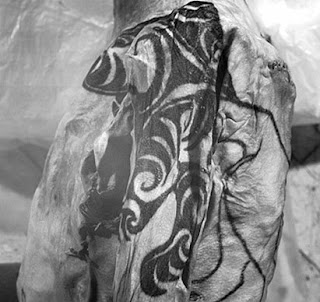
This is an outline drawing of a fish tattoo from a man of the Pazyryk culture; he was discovered in the 1940s. (A larger image of some of his tattoos can be seen in my new title banner.) The Pazyryk people were nomadic horsemen of the mountains in what is now Siberian Russia who flourished between the sixth and second centuries BCE.
 Their burials were rich troves of artifacts including saddles, textiles, tools, horses, hash pipes, cannabis and tattooed people. Although no tattoo-specific tools were found the Pazyryk people did make fine embroidery with extremely small needles; it has been concluded that these needles did double duty as tattoo tools.
Their burials were rich troves of artifacts including saddles, textiles, tools, horses, hash pipes, cannabis and tattooed people. Although no tattoo-specific tools were found the Pazyryk people did make fine embroidery with extremely small needles; it has been concluded that these needles did double duty as tattoo tools. According to this essay on the history of tattoo:
According to this essay on the history of tattoo:The best preserved tattoos were images of a donkey, a mountain ram, two highly stylized deer with long antlers and an imaginary carnivore on the right arm. Two monsters resembling griffins decorate the chest, and on the left arm are three partially obliterated images which seem to represent two deer and a mountain goat. On the front of the right leg a fish extends from the foot to the knee. A monster crawls over the right foot, and on the inside of the shin is a series of four running rams which touch each other to form a single design.
 There are also a series of small circles along the spine that are believed to be therapeutic in nature. Interestingly, modern Siberians practice this form of tattoo to relieve the pain associated with back problems. In the second half of the 20th century more burials and bodies were discovered. All have tattoos of real and mythical animals.
There are also a series of small circles along the spine that are believed to be therapeutic in nature. Interestingly, modern Siberians practice this form of tattoo to relieve the pain associated with back problems. In the second half of the 20th century more burials and bodies were discovered. All have tattoos of real and mythical animals.P.S. Be sure to check out this Hermitage News link for more information about this fascinating culture. And thanks to Luc for the link!!
2 comments:
Hi Livia,
great idea for a blog. Have posted it to metaPagan.
Can I have this post as a guest post for Pagans for Archaeology?
Thanks. Yeah, that'd be great!
Post a Comment